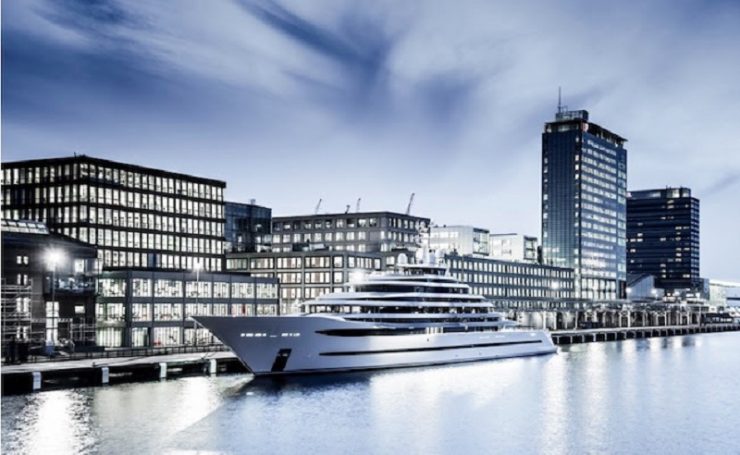FROM drone blocking force fields to motion-detecting smart floors, the kinds of futuristic technologies we are used to seeing in action films are not so far from the reality of today’s top-level security and privacy options for large custom superyachts.
According to Paris Baloumis Oceanco’s Marketing Director said Oceanco accustomed to unique and challenging client requests, from unusual feats of design to remarkable security systems. Here, the custom superyacht builder shares some of the options available for onboard technology that could have come straight out of the pages of a spy novel.
“For custom-built superyachts, there are some owners who choose to opt for secret-service level security and privacy onboard, maybe because they enjoy cutting edge gadgetry or they wish to continue their regular lifestyle while at sea. From drone blocking force fields to motion-detecting smart floors, the kinds of futuristic technologies we are used to seeing in action films are not so far from the reality of today’s top-level security and privacy options for large custom superyachts,” Paris Baloumis said.
And with increasing autonomy and range on today’s vessels, many are heading off the beaten track and into remote waters where local medical back-up might be in shorter supply. In response, the grandest and most well-equipped superyachts can be kitted out with fully functioning hospitals, manned by dedicated medical staff, to provide reassurance.
Meanwhile Marcel Onkenhout Oceanco’s CEO said although the company naturally maintains full confidentiality regarding any specific client’s requirements as well as their identities.
“We bring in experts from inside and outside yachting to consult on high-security projects and adopt technologies from other sectors. What’s more, we take our own security at Oceanco very seriously to maintain privacy during the construction of our yachts; the shipyard is fitted out with high-security systems, too,” he said.
In the extremely rare case that an unwanted visitor boards their yacht, some owners like the reassurance of a secure location to go to. These places are known as ‘citadels’, and they were first put to use in commercial shipping before crossing over to yachting.
Citadels are kitted out with independent, overriding access to the yacht’s navigational and satellite communications systems, so even when you don’t have access to the bridge, you can maintain full control. The rooms themselves are fitted with reinforced doors and have ballistic protection on the surrounding walls. Inside, they are equipped with their own ventilation systems as well as water and food supplies to provide total self-sufficiency.
And the next generation of citadels could be distinctly more mobile. Like crossing a lifeboat with a space ship, these emergency escape ‘Life-Pods’ provide a rapid getaway. The watertight pods are constructed from high-tech materials to resist impact and feature built-in GPS trackers, temperature and fire barrier controls, and air purification systems.
In recent years, drones have been making headlines for their interference with commercial airports, and the military have been particularly keen to curb their capability to spy on top secret locations. As well as being a handy tool for the paparazzi to get up-close shots of a superyacht’s private enclaves and the guests within them, those involved in the murky waters of industrial espionage can thank drones for greatly increasing their capabilities, too.
But a new generation of devices to detect and defeat these drones is emerging to neutralize the occasional threats to privacy and security on yachts. One such defense system identifies any commercial drones in operation within a 20 kilometer radius, providing GPS positions of both the drone and the pilot as well as an indication of said drone’s heading and speed.
Think someone could sneak up on a superyacht by pulling on a wet suit and scuba gear? Think again, as some superyachts are choosing to install sonar systems that detect, track and identify divers or underwater vehicles approaching from any direction.
Perhaps a yacht is expecting to travel to remote regions where on-the-ground medical support is less accessible. Or maybe the Owners are more mature and have specific conditions that mean they seek the reassurance of an onsite doctor or nurse. Either way, an onboard hospital is not an uncommon request for custom superyacht builders.
Kitted out like an emergency room of a private hospital, they are equipped with oxygen tanks, defibrillators, specialized medications and intravenous fluids, while a number of yachts offer rehabilitation machines for injuries, such as decompression chambers for those who are planning on some serious scuba diving expeditions. And should a patient require further medical attention, most of today’s large yachts have a helipad with the possibility of bringing in medic air services to the yacht, or heli-evacuating them away to a larger facility ashore.
Just as any home or office will likely choose to protect itself from outsiders accessing private and personal data, any superyacht could be vulnerable to cyber threats. With the increasing preponderance of wirelessly controlled systems featured onboard, those yachts that do not provide themselves with an added layer of technological security can leave themselves open to hacking. [sources/photo special]
















